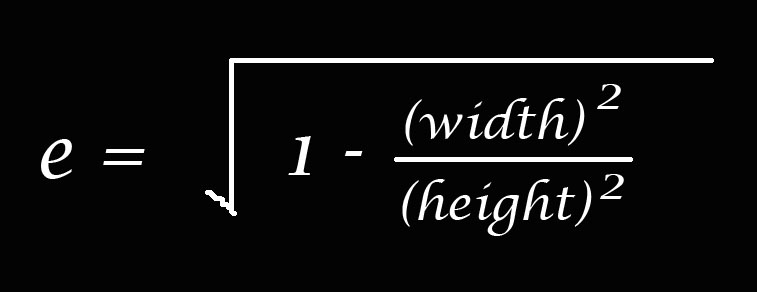Classification of Telegraph date stamps.
- Australia 1901-1988
- New South Wales
- Queensland
- South Australia
- Tasmania
- Victoria
- Western Australia
- International
- Special aspects
There are many classifications of date stamps used in Australia or in its former Colonies. These classifications address the cancellers used for postal purposes and incidentally refer to Telegraph date stamps - see elsewhere for an image of a steel canceller used at Maryborough and a brass hand stamp used for DELAYED MESSAGES.
The Colony/State based nature of these classifications do not accommodate the Australia-wide variations and so a scheme is used in this website to describe all the steel and rubber date stamps which include a reference to Telegraphs across all telegraph authorities. Part of its description rests on the number of circular or oval lines used and their placement. This description follows a logical pattern from the outside of the date stamp in rather than an arbitrary numbering.
The characteristics addressed by the classification are:
- material used for the date stamp: brass (B), rubber (R) or steel (S).
- shape of the date stamp: circular (C), oval (O), rectangular (R) or octagonal (T)
The rectangular shape can be further described as being either a horizontal rectangle (H)
or a vertical rectangle (V). - structure of the surrounding details and the placement of the text.
- type of Telegraph Office.
- eccentricity - to measure the extent of the oval shape from a circle.
Examples of these classifications are demonstrated now follow.
| Material | Circular | Oval | Rectangular |
| B(rass) | 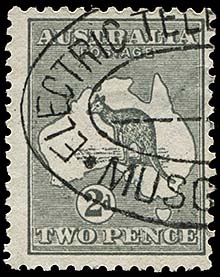 BO - Brass oval. |
||
| R(ubber) | 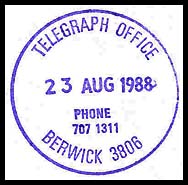 RC - Rubber Circle |
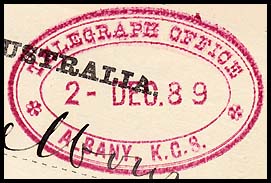 RO — Rubber Oval |
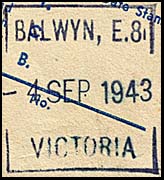 RRV — Rubber Rectangle Vertical |
| S(teel) | 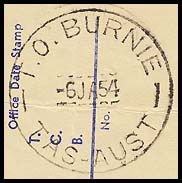 SC - Steel Circle |
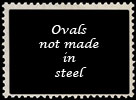 |
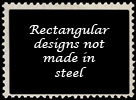 |
The main shapes are circular (C), oval (O) or rectangular (R) as shown above.
| The octagonal shape was only used for the Telegraph Department (TD) in Adelaide so does not need to be classified further with the criteria below related to structure. | 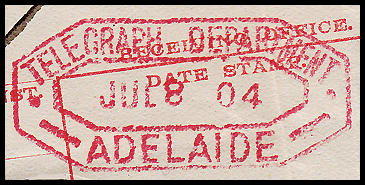 RT3-TD: Adelaide, SA. 8 July 1904. |
The next criterion for classification is the structure of the shape. This criterion comments on how many lines make up the shape, where these lines are positioned and their outline. The possibilities and the codes used are summarised below:
| Code number | Description | Example in a Circle or in a Rectangle |
Example in an Oval |
| 1 | Single line around the outside. | 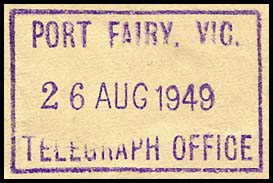 RRH1-TO: Port Fairy, Vic. 26 August 1949. (Rubber Rectangular horizontal 1 line - |
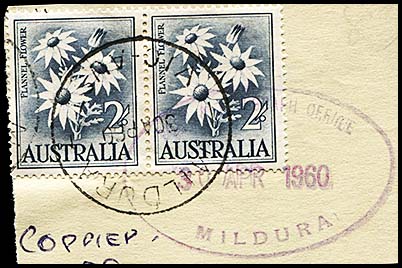 RO1-P&TO. 30 April 1960. Rubber Oval 1 line - Post & Telegraph Office. |
| 2 | Two lines around the outside circumference which are close together. | 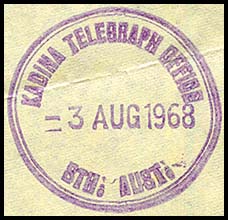 RC2-TO: Kadina, SA. 3 August 1968. Rubber circular 2 lines - Telegraph Office. |
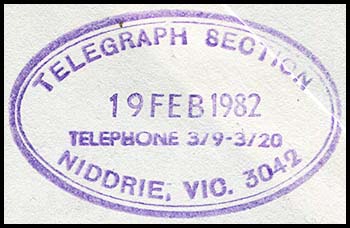 RO2-TS: Niddrie, Vic. 19 February 1982. Rubber Oval 2 lines - Telegraph Section. |
| 3 | Double concentric lines but separated up to about 7 mm for text between them. | 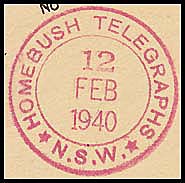 RC3-T: Homebush, NSW. 12 February 1940. Rubber circular 2 lines with |
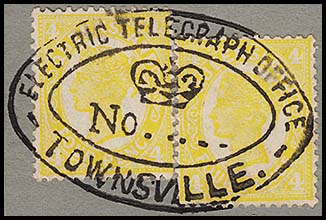 BO3-ETO:Townsville, Qld. No date. Brass oval 2 lines with 1 line separated to the interior - Electric Telegraph Office. The Belt & Buckle design of Victoria (RO3) would also be classified here. |
| 4 | Two lines - The outside line is continuous. The inner line is wavy/scalloped. There is text between the outer and the inner lines. |
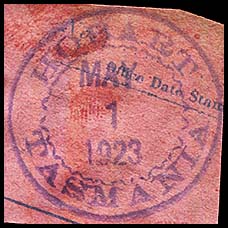 RC4: Hobart, Tas. 1 May 1923. Rubber circular outer line. See also a second example for Arncliffe. |
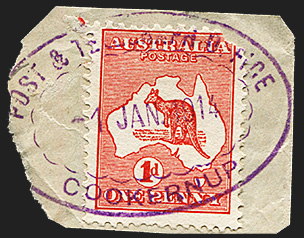 RO4-PTO: Cookernup, WA. 1 January 1914. Rubber outer oval is a single line. |
| 5 | Triple lines at the outside. | 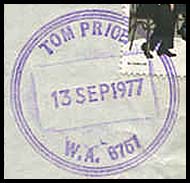 RC5: Tom Price, W.A. 13 September 1977. Rubber circular date stamp |
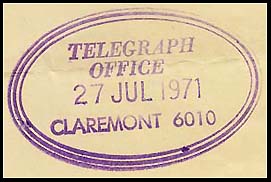 RO5-TO: Claremont, WA. 27 July 1971. Rubber oval three lines all on the outside - |
| 6 | Double lines at the outside and a continuous line inside with text between. | 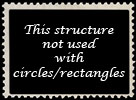 |
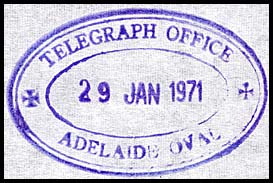 RO6-TO: Adelaide Oval, SA. 29 January 1971. Rubber oval three lines with two on the outside and one separated to the interior - Telegraph Office. |
| 7 | Double lines at the outside and a wavy/scalloped line inside with text between. |  |
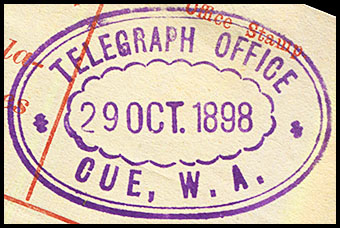 RO7-TO: Cue, WA. 29 October 1898. Rubber oval three lines with two on the outside and one scalloped and separated to the interior - |
The final category for the classification is the type of telegraph office. Information on this category is added to the end of the above by adding the initials of the type of office indicated on the date stamp.
For example:
- the Electric Telegraph Office for Townsville would add the letters ETO.
- the Homebush TELEGRAPHS would add T.
- the Burnie Telegraph Office would add TO.
Examples of the addition of this category are included in the above table.
The oval shape used for many Telegraph date stamps in almost all Colonies/States - South Australia appears to be the exception although it does have its octagonal date stamps - is more properly termed an ellipse. This shape is an important member of the Conics family in Mathematics which also includes circles, parabolas and hyperbolas.
Eccentricity is a measure of the extent to which an oval shape (i.e. an ellipse) differs from being a circle.
- if a shape is purely circular, the eccentricity is 0.0;
- if a shape is very flat, the eccentricity is closer to 1.0.
Most oval date stamps have an eccentricity - or e value - between about 0.68 and 0.80. To illustrate the values, some examples are provided:
Tending to a flat shape.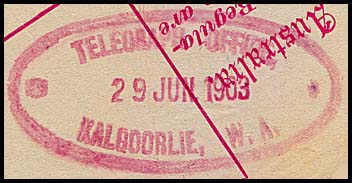 Kalgoorlie Telegraph Office in red. 29 June 1903. RO2 - TO. Size: 26 × 54 mm (e = 0.88). |
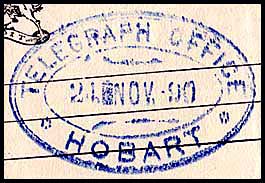 Telegraph Office/Hobart in blue. 24 November 1890. RO6 - TO. Size: 27 × 41 mm (e = 0.75). |
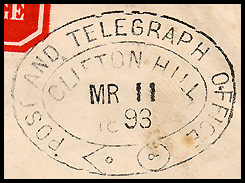 Clifton Hill Belt & Buckle - 1 hole in black. 11 March 1893. RO2 - B&B. Size: 28 × 38 mm (e = 0.68). |
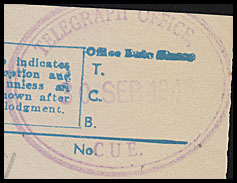 Cue Telegraph Office in violet. 30 September 1946. RO2 - TO. Size: 33 × 43 mm (e = 0.64). |
Tending towards a circle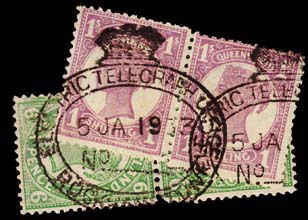 Rockhampton Electric Telegraph Office. 5 January 1905. RO2 - ETO. Size: 27 × 34.5 mm (e = 0.62). . |
The calculation for eccentricity (e) uses the height of the date stamp and the width:
